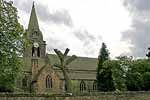 Underwood Underwood
St Michael and All Angels
History
In 1883 the small population of Underwood sought to establish a church, but little progress was made until 1887 when the new vicar of Selston Church, the Rev. Charles Harrison, saw the need to establish a new church in Underwood. At that time mission services were held in the schools at Underwood and nearby Bagthorpe. In his quest he approached the major local landowner, Earl Cowper of Beauvale. The impetus for funding the building of a church at Underwood came from the Earl. He visited the site in 1887 to discuss the need for a church and burial ground. At that time there were few houses close to the site or in Underwood village. He took total control of the project, choosing and donating the elevated site, appointing the architect and the building contractor, and organising the purchase of most of the building materials, the bricks, stone and timber being sources from quarries, brickyards and woods located in places where he owned land. He paid the entire cost of the project which was £5,000. The Earl’s income in 1880 was recorded as £60,000 a year. He had land in eleven counties throughout England.
Underwood was not entirely without a place of worship, as a Christian Meeting House had been erected in 1873 (now a Baptist Church). The new church dedicated to St. Michael and All Angels was consecrated on 29 September 1890. The village of Underwood started to grow with new houses being built opposite the church and on other sites in the early twentieth century, and the local authority built twenty council houses in the 1920s. Housing development continues today. Much of the growth of Underwood was the result of developments in coal mining. Although small coal pits had been a feature of the area for many years a more modern colliery was established at Underwood in 1852. The shaft was widened and deepened in 1876 and the pit renamed Selston Colliery (it was renamed Pye Hill No. 1 Colliery in the early 1970s). The colliery closed in 1985.
A 'grand bazaar of useful and fancy articles' was held at the school in Underwood in September 1897 with the aim of clearing the debt of £90 on the new organ. Thanks to the untiring efforts of the curate-in-charge, the Rev A. Lilley, sufficient funds had been raised to place an order with Messrs Porritt of Leicester the previous year. The organ was opened by the Bishop of Southwell on 14 October 1896.
On 30 July 1905 the church was the scene of the memorial service for Francis Thomas de Grey, seventh Earl Cowper. The location was fitting as the church 'owed its erection entirely to his lordship's munificence.'
A memorial window 'erected to perpetuate [the memory of] the complete sacrifice' that 34 local men made during the First World War was unveiled on 5 September 1920 by General Lord Playfair. In addition to Biblical figures the window contains two medallions showing the ruins of Ypres cathedral and Arras where some of the bitterest fighting took place.
In 1934 the church was broken into twice. According to the Nottingham Journal on the second occasion 'the west end window had been broken and the leaded lights torn away. The safe in the vestry was found broken open, but fortunately there was nothing of any value in it except the wine used for communion.' The police were hopeful that fingerprints could be lifted from the empty wine bottle.
The records of the church are held by Nottinghamshire Archives with Baptisms Registers dating from 1890. Marriages and Burials date from a little later.
Underwood has predominantly been a united parish; initially the Parish of Selston with Underwood until 1949, and in 1955 it was united with Brinsley by Royal Decree to form the Parish of Brinsley and Underwood.
| 




